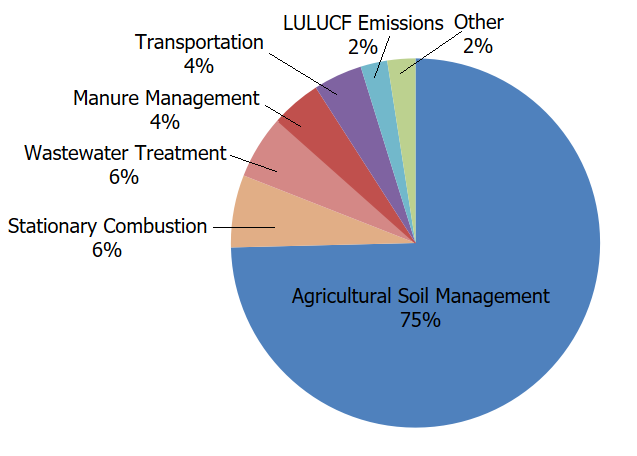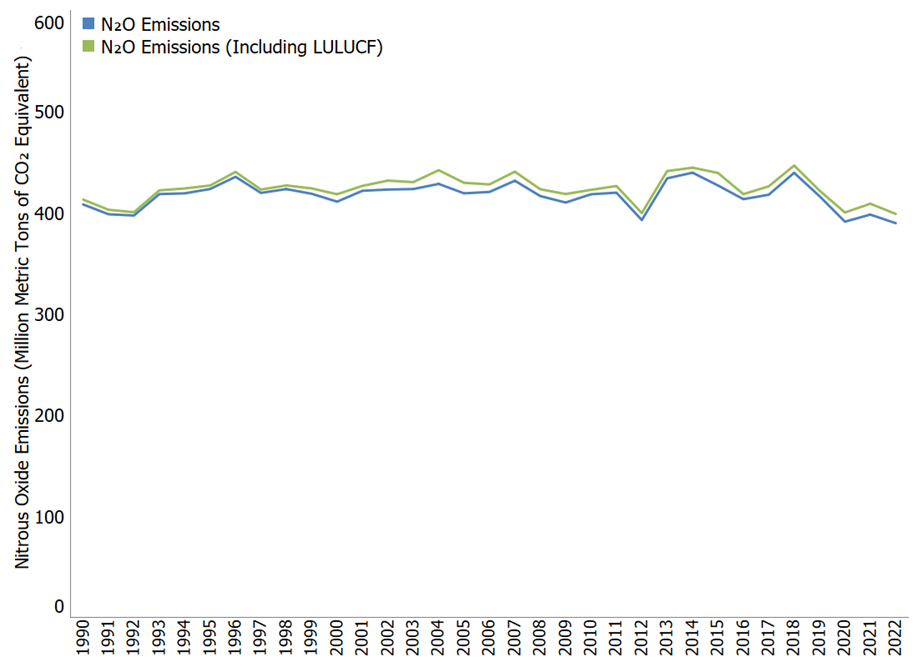Nitrous Oxide Emissions
Chemical Formula: N2O
Lifetime in Atmosphere: 114 years
Global Warming Potential (100-year): 2651
On this page:
Sources of Nitrous Oxide Emissions
In 2022, nitrous oxide (N2O) accounted for 6% of all U.S. greenhouse gas emissions from human activities. Human activities such as agriculture, fuel combustion, wastewater management, and industrial processes are increasing the amount of N2O in the atmosphere. Nitrous oxide is also naturally present in the atmosphere as part of the Earth's nitrogen cycle and has a variety of natural sources. Nitrous oxide molecules stay in the atmosphere for an average of 121 years before being removed by a sink or destroyed through chemical reactions. The impact of 1 pound of N2O on warming the atmosphere is 265 times that of 1 pound of carbon dioxide.1
Globally, 40% of total N2O emissions come from human activities.2 Nitrous oxide is emitted from agriculture, land use, transportation, industry, and other activities, described below.
- Agriculture and Land Use, Land-Use Change, and Forestry sector. Nitrous oxide can result from various agricultural soil management activities, such as application of synthetic and organic fertilizers and other cropping practices, the management of manure, or burning of agricultural residues. Agricultural soil management is the largest source of N2O emissions in 2022. While not shown in detail in the figure and less significant, emissions of N2O also occur as a result of land use and land management activities (e.g. forest and grassland fires, application of synthetic nitrogen fertilizers to urban soils (e.g., lawns, golf courses) and forest lands, etc.).
- Fuel Combustion. Nitrous oxide is emitted when fuels are burned. The amount of N2O emitted from burning fuels depends on the type of fuel and combustion technology, maintenance, and operating practices.
- Industry. Nitrous oxide is generated as a byproduct during the production of chemicals such as nitric acid, which is used to make synthetic commercial fertilizer, and in the production of adipic acid, which is used to make fibers, like nylon, and other synthetic products. Nitrous oxide is also emitted from use in other applications such as anesthesia and semiconductor manufacturing.
- Waste. Nitrous oxide is also generated from treatment of domestic wastewater during nitrification and denitrification of the nitrogen present, usually in the form of urea, ammonia, and proteins.
Nitrous oxide emissions occur naturally through many sources associated with the nitrogen cycle, which is the natural circulation of nitrogen among the atmosphere, plants, animals, and microorganisms that live in soil and water. Nitrogen takes on a variety of chemical forms throughout the nitrogen cycle, including N2O. Natural emissions of N2O are mainly from bacteria breaking down nitrogen in soils and the oceans. Nitrous oxide is removed from the atmosphere when it is absorbed by certain types of bacteria or destroyed by ultraviolet radiation or chemical reactions.
To find out more about the sources of N2O and its role in warming the atmosphere, visit the Climate Change Indicators page.
Nitrous Oxide Emission Trends
Nitrous oxide emissions in the United States decreased by 3% between 1990 and 2022. During this time, nitrous oxide emissions from mobile combustion decreased by 56% as a result of criteria pollutant emission standards for on-road vehicles. Nitrous oxide emissions from agricultural soils have varied during this period and were about the same in 2022 as in 1990.
Reducing Nitrous Oxide Emissions
There are a number of ways to reduce emissions of N2O, discussed below.
| Emissions Source | Examples of How Emissions Can be Reduced |
|---|---|
| Agriculture |
|
| Fuel Combustion |
|
| Industry |
|
References
1IPCC (2013). Climate Change 2013: The Physical Science Basis. Contribution of Working Group I to the Fifth Assessment Report of the Intergovernmental Panel on Climate Change. [Stocker, T.F., D. Qin, G.K. Plattner, M. Tignor, S.K. Allen, J. Boschung, A. Nauels, Y. Xia, V. Bex and P.M. Midgley (eds.)]. Cambridge University Press, Cambridge, United Kingdom and New York, NY, USA, 1535 pp.
2IPCC (2021). Climate Change 2021: The Physical Science Basis. Contribution of Working Group I to the Sixth Assessment Report of the Intergovernmental Panel on Climate Change [Masson-Delmotte, V., P. Zhai, A. Pirani, S.L. Connors, C. Péan, S. Berger, N. Caud, Y. Chen, L. Goldfarb, M.I. Gomis, M. Huang, K. Leitzell, E. Lonnoy, J.B.R. Matthews, T.K. Maycock, T. Waterfield, O. Yelekçi, R. Yu, and B. Zhou (eds.)]. Cambridge University Press, Cambridge, United Kingdom and New York, NY, USA, 2391 pp.
3EPA (2005). Greenhouse Gas Mitigation Potential in U.S. Forestry and Agriculture. U.S. Environmental Protection Agency, Washington, DC, USA.


